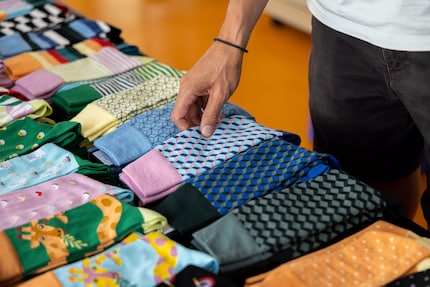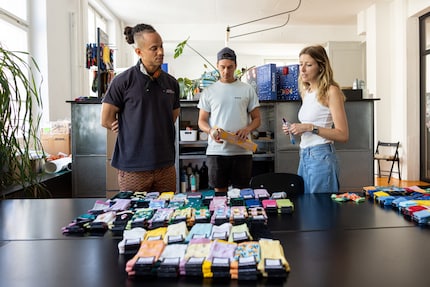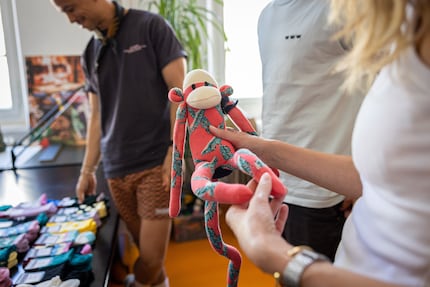

DillySocks: «Lots of brands make socks, but few do so exclusively.»
Three twentysomethings take a trip to London and come back with a start-up idea. Ten years later, they welcome me to their Zurich headquarters and give me an insight into their colourful and, more than anything else, sustainable sock universe.
I’ll hold my hands up and admit socks haven’t interested me in the slightest until now. Mine are black or white, and I prefer them to be inconspicuous on all levels. No drawing attention, no sliding down, no cutting into my ankles. Nevertheless, a few weeks ago, I found myself drafting an email to the founders of DillySocks. Why? I really wondered how anyone could develop such a passion for socks that would allow them to build an entire business around them. Every conceivable shape and colour, an endless assortment of designs, and all with an impressive focus on sustainability.
«It’s high time that socks play a more important role in your life, too. You’re always welcome. When do you have time to pop by?» reads the answer to my inquiry. Not long afterwards, I’m standing with Sean Pfister and Fabian Knup, two of the three founders of DillySocks, at their headquarters in Zurich’s Kreis 3 district. All of a sudden, nothing is black and white here any more.
** In 2013, you had your idea for DillySocks. Why socks?**
Sean Pfister: On our trip to London, we noticed all kinds of beautiful, brightly coloured socks. So we bought a few pairs. Once back home, we were asked by an amazing number of people where we got them. After a bit of research, we discovered there’s high demand for stuff like it in Switzerland, but there’s no availability. So, without further ado, we secured the brand name DillySocks, built our first store and distributed socks from other brands here in Switzerland. This then developed into the idea of starting a business all of our own.
Where do you start once you’ve cemented the initial idea?
Sean Pfister: We got requests for specific designs pretty quickly. So we started looking for a producer and finally found one in Portugal. We still work together today and have a very good relationship.

Source: Christian Walker

Source: Christian Walker
Were you clear from the outset that DillySocks should be a sustainable company?
Sean Pfister: We have always intuitively had an affinity for sustainability. It started with working conditions, then gradually we optimised our products more and more in the direction of sustainability via the Ökotek standard (in German), switching to organic cotton and gaining GOTS certification (in German).
Fabian Knup: We were 27 when we founded the company. Of course we wanted to produce as locally as possible, but first and foremost, we wanted to focus on fair conditions and adhering to standards. Today, we can say we’re no longer just climate neutral, but even climate positive.
Is that also because of your packaging?
Sean Pfister: Our labels and boxes come from Portugal. The special thing about our packaging is we’ve replaced the small plastic hooks with ones made of biocomposite. We found a company in Switzerland that makes different plastic substitutes from it. What’s more, we also remove the hooks for each shipment beforehand. Our retailers usually remove them when an item is sold and send them back to us so we can reuse them.
Has the sustainability aspect also put obstacles in your way?
Sean Pfister: Definitely. The GOTS certification has got a lot to answer for when it comes to my grey hairs. It’s not like you can just make the decision to be more sustainable yourself. Instead, all your producers and every single supplier in the value chain has to be on board and want to put in the additional effort. It involves regulations. For instance, cotton has to be stored separately.
Why?
Fabian Knup: So that it doesn’t get contaminated. It comes to mind more with food, but you also get toxins in textiles. If other types of cotton are treated alongside it and they’re stored in the same place then that causes problems. Of course, there’s a reason for it, but the work involved is extensive. Fortunately, we already had a very good relationship with our partners for a long time, so they were all willing to take part.
You also produce DillyMonkeys. What’s the story with those?
Sean Pfister: Remnants don’t sell very well. That’s why we started this project about three or four years ago. It was a customer who got us cottoned onto the idea. We looked for different workshops that employ people with disabilities or those who are trying to re-integrate into society. We send them our leftovers and slow sellers and they give them a second lease of life as sock monkeys.

Source: Christian Walker
Fabian Knup: Upcycling and the circular economy are becoming increasingly important. We’re trying to get more and more into this. For instance, we want to compost as much as possible so that there’s no waste at all. Or develop products that become part of the circular cycle. For many brands, sustainability is still just a box-ticking exercise. But I think customers still realise which brands are really sustainable and which are prepared to forge new paths to achieve this.
Where do you get the inspiration for your colourful designs?
Sean Pfister: All team members can add their ideas to a document throughout the year. Obviously, it’s all thanks to the design team at the end of the day. But things like search volume, direct inquiries from retailers and the seasons play a role. This lets us develop concepts and thematic worlds, which we then use as the starting point for our designs. Of course, there are also evergreens that are constantly in demand and therefore keep coming back.
Is there a bestseller design you’ve stocked from the start?
Sean Pfister: That would have to be the flamingo. It really is an all-time classic. We were still debating whether to include it in the collection at all – and now sales are going through the roof. Year after year. Avocados, chili, and dogs and cats always do well too. Our dice pattern has also been with us since day one.
Fabian Knup: More than anything, we want to offer a very broad selection. Lots of brands make the odd pair of socks, but very few focus on the sock market exclusively. Think stripes, dots, beautiful colours, designs for all occasions – we want there to be something for everyone.
Do you have a personal all-time favourite sock design?
Sean Pfister: It’s funny every time someone asks me that, I answer differently. Right now I’m in a stripe phase. Generally speaking, I actually try to wear the latest collection and then end up preferring the new designs. Today, for example, I’m wearing our empowerment socks. I always enjoy small statements.

Source: Christian Walker
Fabian Knup: It changes for me, too. The classic white tennis sock is, of course, on trend again. And I try to stay young, which is why I often wear them. Otherwise, I really like our solid colour ribbed socks. Apart from that, flamingos always go down well.
It’s summer now – a time for unleashing feet. Does your store still do business during this season?
Fabian Knup: Socks should and can always be worn – except perhaps in sandals. And we have a wide range of footwear and trainer socks that do very well in summer. The aforementioned tennis sock trend is also generating a lot of sales right now. However, our peak phase tends to be towards the end of the year and during key holiday times.
Sean Pfister: Christmas is our peak season.
What do you know about socks in 2023 that you didn’t know in 2013?
Sean Pfister: So much. About the structure of a sock alone. There’s a tip. But not all tips are the same. It has a finish, which can easily cause pressure points. There’s a heel. And that’s not always the same: sometimes it’s reinforced, sometimes not. You have to find that out first. There’s one leg part of the sock, which comes in different heights. The cuff on it might cut in or it might not.
Fabian Knup: It’s even worth noting how many needles are used to make a sock. It depends on sock quality and how clear you want the design to be.
Is it a case of the more needles the better?
Fabian Knup: Exactly.
Last but not least: why the name DillySocks?
Fabian Knup: Fortunately, that’s quite easy to answer. We were looking for a synonym for extraordinary. Dilly is another word for excellent in North America. We liked the fact that it’s not too common an expression. It’s just a cool word that sounds good, stands for something and looks nice.

Source: Christian Walker
Always in the mood for good hits, great trips and clinking drinks.
Interesting facts about products, behind-the-scenes looks at manufacturers and deep-dives on interesting people.
Show allThese articles might also interest you

Background information
A reflective nation: lessons in visibility from Finland
by Martin Jungfer

Background information
The messy side of the make-up industry: «I didn’t want to be part of the problem»
by Natalie Hemengül

Background information
Dagsmejan founder: «At the beginning, people laughed at us. Now, they try to copy us»
by Martin Jungfer




